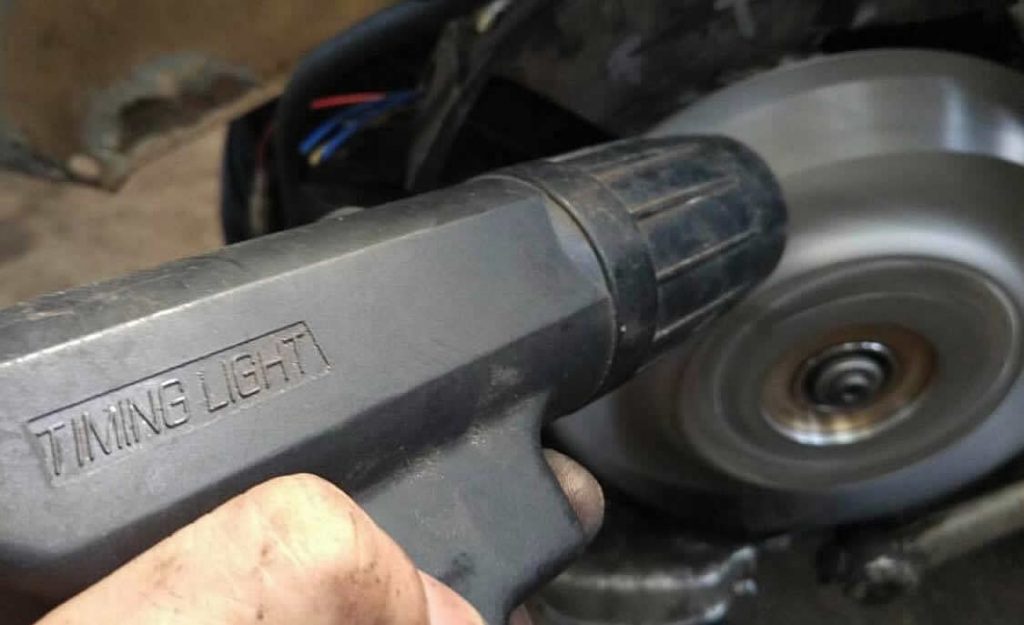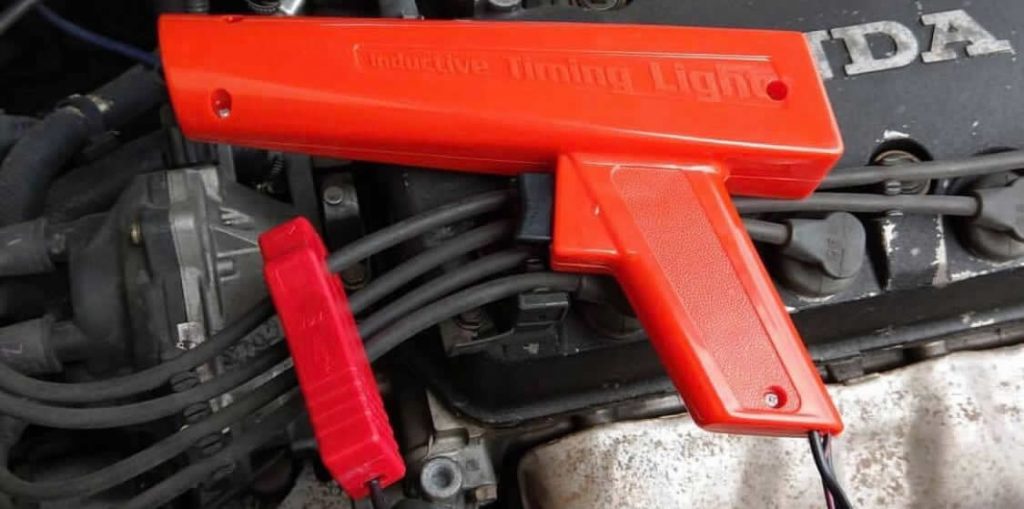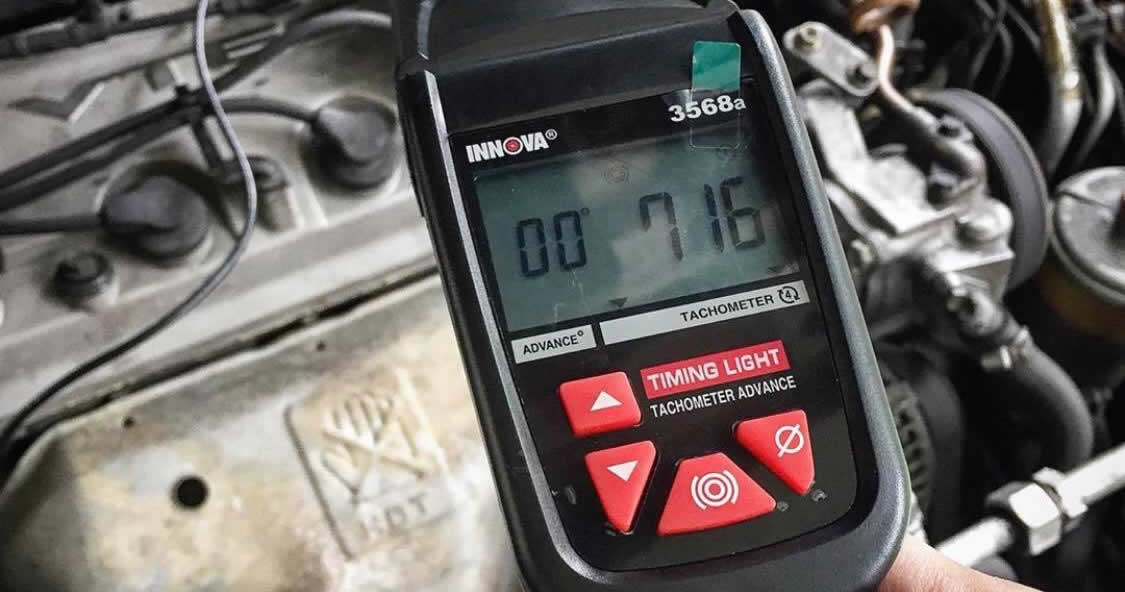A timing light is used to fine tune when the spark from the spark plugs fires and ignites the fuel. If the timing is off, the engine will suffer from knocking, which is the result of fuel, air and spark igniting at the wrong time.
The best timing light is the INNOVA 5568, which provides a four function digital readout of the tachometer, advance, dwell and voltage.
Timing lights are now available as digital devices with additional functionality such as advance, dwell, voltage and much more. However, many of these functions are suited to professionals that need to further fine tune the timing.
Table of Contents
Best Timing Light
| Timing Light | RPM Reading | Type |
|---|---|---|
| INNOVA 5568 | 249 - 9,990 | Digital |
| Actron CP7529 | 0 - 9,999 | Digital |
| Performance Tool W80587 | 0 - 9,000 | Digital |
| ESI 130 | 0 - 14,000 | Self-Powered |
| MSD Ignition 8992 | 0 - 9,999 | Standard |
Whether you want to diagnose issues or fine tune the ignition system, a timing light is an essential tool. They are available in several forms that are suited to beginners or professionals that use the device on a daily basis.
A timing light is an advanced tool, which if you know and understand ignition systems can be a highly beneficial for achieving the best performance.
Below is a list of the best timing lights that allow you to easily diagnose or fine tune most ignition systems.
INNOVA 5568 Pro Timing Light
The INNOVA brand are known for their automotive multimeters but they also produce many timing light devices. The 5568 model is the highest performing timing light that is able to display tachometer ranges from 249 to 9,990 RPM.
A defining feature of all INNOVA timing lights is the adjustable barrier. The benefit of this design means that you can adjust the barrel for better aim at the timing mark.
Other features of the INNOVA 5568 Pro-Timing include:.
- Compatible 2 and 4 cycle engines
- Displays tachometer, advance, dwell and voltage
- Patented skip circuitry test
- Detachable 6 foot leads
- Heavy duty shock proof housing
- Includes a molded storage case
The plug in and play design along with an intuitive LCD display makes the 5568 model very easy to use. It is the best timing light for the money with the popularity being a clear sign that INNOVA have produced a great piece of kit.
Check it OutActron CP7529 Digital Timing Light
The Actron CP7529 is another digital timing light that can be used to measure the RPM and advance as well as setting initial timing. Unlike cheaper alternatives, this model uses a super bright xenon flash that is highly visible.
In terms of the compatibility, you can use this timing light with all gasoline engines with conventional, electronic, computer controlled, DIS or 2 cycle ignition systems.
Other features of the Actron CP7529 Digital include:
- Microprocessor controlled circuitry
- Bright LED display
- Measure advance to 1/10
- Displays tach readings from 0 to 9,999 RPM
- Durable ABS housing with heat resistant battery clips
- Includes instructions and a 1 year warranty
Overall, it is an excellent all-round timing light that features the desirable bright light flash that can be seen in daylight. Whether you are tackling a car, truck or boat engine, the Actron CP7529 will not disappoint.
Check it OutPerformance Tool W80587 Advance Timing Light
The Performance Tool W80597 is the cheapest digital timing light that can be used for precising diagnostic and tuning tasks. It will display the engine speed up to 9,000 RPM and ignition spark advance from 0 to 90.
If you don’t require a digital model, the brand also produce other timing lights that are self powered, measure just the tachometer and much more.
Other features of the Performance Tool W80597 include:
- Super bright xenon flash
- High-Vis LED display
- Push button control to adjust between 2 and 4 cycle
- Tough ABS shell and thick wires
- Compatible with 12 volt systems
Overall, it is able to performing similar to the premium options but without the expensive price tag. It is a cheap timing light that is worth the money that is built to last with thick wires and a rugged construction.
Check it OutESI 130 Self-Powered Timing Light
The ESI 130 is a self-powered timing light that is suitable for all ignition systems as well as 2 or 4 cycle engines. The brand claim that it will provide accurate reading up to at least 14,000 RPM, which is the highest within this article.
Unlike other timing lights that require a 12 volt battery, the ESI 130 uses two “D” cell batteries for powering the device.
Other features of the ESI 130 Self Powered include:
- Compatible with a range of engines
- Bright flash at all speeds
- 4 feet lead length
- Heat protective sleeve
- Heavy duty construction
- Includes batteries
Although it lacks the digital display for reading tachometer readouts, it is still one of the best timing lights available. With accurate readings to 14,000 RPM and no need to connect to a 12V battery, it is highly desirable model for many people.
Check it OutMSD Ignition 8992 Timing Light
The MSD Ignition 8992 is a timing light built for professional mechanics that require a durable device. It is an inductive timing light that works with all ignition types and provides stable signals from 0 to 10,000 RPM.
The brand claim that the patented flash used within this device is three times brighter than standard alternatives, which is highly impressive.
Other features of the MSD Ignition 8992 include:
- Uses a metal inductive pickup
- Built to withstand the toughest garage environment
- Heavy duty resin casing that is easy to clean
- Detachable for storage
- Intense strobe is visible in the daylight
Overall, it is a well-made timing light that provide accurate readings and will not disappoint. The main drawback is that it has no digital display, which considering the high price tag, many people would expect.
Check it OutTiming Light Buying Guide
The use of a timing light is required to fine tune when the spark fire from the spark plugs and ignites the fuel injected into the engine. If the timing is not accurately tuned, the engine will fail to produce peak power and efficiency.
Timing lights have improved over the years and include more features than ever. Choosing between the different units is a matter of preference as many people may only require the basic functionality.
To help you make an informed buying decision, we have produced the below guide regarding timing lights.

Symptoms of Bad Timing
If you are sensing misfires, thumping or shudder whilst driving, it is more than likely the timing is off. Most mechanics will state that the engine is knocking, which is caused by the fuel and air mixture incorrectly igniting.
Another symptom is no spark advance, which is where the engine idles correctly but struggled during acceleration. This can usually be solved by the vacuum or mechanical advance being slightly tweaked to ignite earlier.
Depending upon the age of the car, a “Check Engine” light may be the first indication that something is wrong. If you have access to an automotive diagnostic scanner, you will be able to find the exact issue with the engine.
Digital vs Standard
The standard analog timing light has been used by mechanics for many years. It is the most reliable method but it does require knowledge of the basic functionality of the system. The digital alternative will be more expensive but is easier to use and offers many more features. These include advance, tachometer and voltage readings that allow you to fine tune the engine timing.
Usable Functions
Along with the standard functionality of a timing light, they also offer a range of additional functionality that is used to fine tune the engine timing.
The tachometer is a desirable feature that accurately reads the RPM and found in most digital devices. The advance timing light functionality allows you to adjust the total timing and is found in both digital and analog devices.
The dwell is the space between the piston and where the spark plug must fire. It refers to the movement of the piston until the fuel ignites, which can be adjusted depending upon your requirements. It is an advanced feature that only professionals or tuning enthusiasts will require.
Many timing lights will include a voltage function, which measure the voltage generated by the spark plug during ignition.
Light Brightness
An important feature of any timing light is the brightness of the flash and whether it can be seen. Not everyone is lucky enough to have a garage, which means that they will need to be seen within daylight, which many cheap units struggle with.
Ease of Use
Older timing lights were notoriously difficult to use and manufacturers have gone to great lengths to improve this issue. Most make use of a plug and play design that can be aimed at the ignition for instant readings. Many also allow you to check the dwell, RPM and battery voltage to further fine tune your engine.
In terms of setting up the timing light, many require a 12V battery, which is used as a power supply. Unless you have a spare car battery in the garage or the battery is easily accessible, it can be an issue for many mechanics. However, if that is the case, a self powered timing light would be the best option.
When it comes to storage, detachable leads and a storage case are highly recommended. Without them, the wires can become damaged fairly easily and it can be difficult to store.

Design and Durability
Timing lights come in different shapes and sizes but you will want to ensure it has a rugged construction. They will not include a metal casing due to the risk of being electrocuted but will instead use heavy duty ABS housing. The benefit of this is that it is durable, easy to clean and shock proof in case it is dropped.
Unless you are a professional mechanic, you will not be using a timing light of a regular basis. Therefore you will want an easy to store and durable device that can withstand the garage environment. Many timing lights include detachable wires and a carrying case, which make the storage far easier.
How Does a Timing Light Work
A timing light uses an inductive clamp, which reads the pulses passing through the spark plug wire that is firing. Each time the coil pack or distributor passes current through the wire to the spark plug, the timing light will fire a bright flash.
Whilst the engine is running and the transmission is in park, you can begin to use the device. In short, you simply pull the trigger of the timing light and it will flash each time the number 1 spark plug is fired. The usage of the device differs depending upon the engine and the timing light that you are using.
Conclusion
Timing lights have seen a huge improvement over the years and are far more advanced than they once were. The popularity of digital units has exploded and it allows you to further fine tune your engine for the best performance.
All of our recommendations are suited to a range of budgets and include standard, self powered or digital units. As timing lights is not a tool used on a regular basis, we advise that you choose one that is rugged and can be easily stored.






